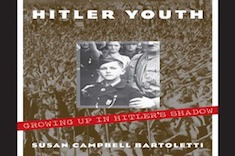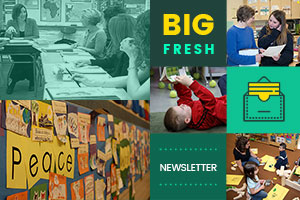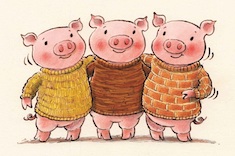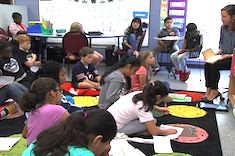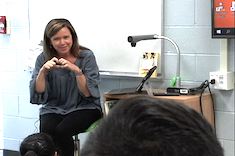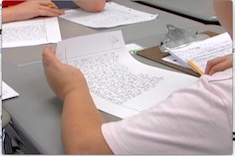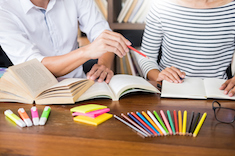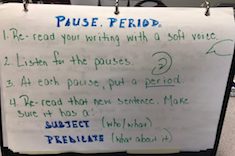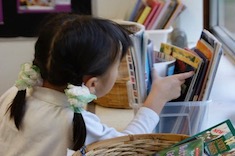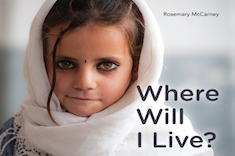Library
Choice Literacy Articles & Videos
The Choice Literacy library contains over 3,000 articles and 900 videos from 150+ contributors. Classic Classroom and Literacy Leadership subscribers have access to the entire library. Content is updated continuously, with five to six new features published each week.
Latest Content
Magic Connections: Young Adult Literature in a Social Studies Class
Mark Levine shows how young adult literature is a potent tool to drive learning in his middle school social studies classroom.
November 15, 2019 In Praise of Clutter
This week we look at how to use anchor texts in classrooms.
When Learning Gets Tricky, Go Back to the Pigs
Whenever a tricky literary concept comes up, Tammy Mulligan finds herself returning to a favorite mentor text to guide students. She explains the value of shared simple stories for understanding complicated literary elements.
Writing Endings Minilesson in Fifth Grade
A classic anchor text for many teachers is Charlotte’s Web. In this week’s video, Dana Murphy seamlessly integrates a brief excerpt from it into a writing minilesson on endings in her fifth-grade classroom.
Mentor Text Craft Guides
Melanie Meehan helps students see the craft moves in mentor texts by tucking brief guides into many of her favorite children’s books in the classroom library.
November 8, 2019 The Gift of Noticing
We look at reflection in this week’s newsletter.
The Freewrite Pause
Mark Levine finds his middle school students need more time to digest learning from brief articles. Freewriting provides the perfect pause for promoting more reflection and insight.
November 1, 2019 Romancing the Em Dash
We look at how to teach conventions in this week’s newsletter.
October 25, 2019 Candy Bombs
We look at how to develop and use text sets in this week’s newsletter.
Reinforcing Workshop Norms
In this quick video, Dana Murphy shows how she leads her fifth graders with a kinesthetic reminder of workshop norms before beginning independent work.
Fifth-Grade Small Group: Paragraphs
Dana Murphy meets with a group of fifth graders to help students develop paragraphing skills, using a peer’s mentor text.
Mastering Conventions
Even eight-year-olds are expected to master a dozen or more conventions. Melanie Meehan shares a process for helping students focus on the small steps needed to master any convention with peer support.
Text Set Resources
Melanie Meehan shares some of her favorite resources for developing text sets.
October 18, 2019 Offers and Offerings
We look at writing shares in this week’s newsletter.
Helping Students Understand What Works for Them
Want students to become more independent? Melanie Meehan recommends that you take each student through a reflective process to figure out what learning processes and habits work for them.
Whole-Class Reflection in Middle School
Mark Levine explains why whole-class reflection is an essential component of his middle school workshops.
October 11, 2019 Instagram vs. Google Selves
We look at building reader identities in this week’s newsletter.
Teaching Conventions in Small Groups
Dana Murphy finds it is best to teach conventions in small, targeted groups in her fifth-grade classroom. She explains how she designs and leads these groups.
Conferring to Connect: First-Grade Reading
Bitsy Parks confers with first grader Ella about the Brown and Pearl book series, and then listens to Ella read. She closes the conference by encouraging Ella to make more personal connections to books.
Building Reading Identities Across the Year
The start of the school year is often all about building reader identities in classrooms. And then October comes, and many of the activities that help students celebrate their reading histories and preferences are forgotten. Tara Barnett and Kate Mills share ways teachers can continue to help students define, refine, and expand their reading identities all year long.
Text Sets: Reading Beyond Just Facts
Franki Sibberson explains how carefully curated text sets can help students move beyond a “just the facts” exploration of nonfiction topics.
Finding Time for Writing Shares
Finding time for writing share sessions may begin with trying out a few different options to see what works in your classroom. Melanie Meehan presents some of her favorites.
Writing Share Circle in Fifth Grade
Here are some excerpts from a writing share circle in Dana Murphy’s fifth-grade classroom. Each student shares a one- to two-sentence excerpt from the writing they completed during the day’s workshop.
Circle Share
Sometimes “winging it” because we don’t have plans can lead to the most profound learning. Dana Murphy dreams up a quick circle share, and what follows is magic.
Creating a Realistic Fiction Stack
Katherine Sokolowski confers with a fifth grader who is looking for book recommendations. She creates a stack of realistic fiction books based on the student’s interests.
Textual Lineage
Christy Rush-Levine uses book covers to help her middle-school students explore their histories (or “lineages”) as readers.
October 4, 2019 50 Pages
We consider how to deal with classroom and schoolwide interruptions in this week’s newsletter.
Big Table Writing
Max Brand uses the “big table” in his kindergarten classroom as a communal spot for writing. You can see how he interrupts students naturally to make quick suggestions, and allows some interruptions of his own writing as he works with his students.
Minimizing Interruptions During Workshops
Dana Murphy explains why a system for minimizing interruptions is essential in her fifth-grade classroom, and how she keeps the process of creating and using it as simple as possible.
Field Notes: Preserving Minilesson Time
Ruth Ayres shows how one first-grade teacher saves precious time by not ending minilessons with lots of directions for independent work.
Browse Content By
Type
Category
- Assessment Tools
- Big Fresh Archives
- Booklists
- Choice Numeracy
- Classroom Design
- Common Core
- Community Building
- Conferring
- Content Literacy
- Digital Literacy
- English Language Learners
- Equity
- Family Relations
- Free Samples
- Guiding Groups
- Leadership
- Literacy Coaches
- Mentor Texts
- Minilessons
- New Teacher Mentors
- Podcasts
- Poetry
- Quote Collections
- Reading Strategies
- Self Care
- Struggling and Striving Learners
- Talking and Listening
- Teacher Study Groups
- Teaching Reading
- Teaching Writing
- Word Study and Vocabulary
Author
- Melissa Quimby
- Nawal Qarooni
- Gwen Blumberg
- Julie Cox
- The Lead Learners
- Hannah Tills
- Josie Stewart
- Ruth Metcalfe
- Mallory Messenger
- Becca Burk
- Jodie Bailey
- Vivian Chen
- Mary Brower
- Tiffany Abbott Fuller
- Stephanie Affinito
- Ruth Ayres
- Leigh Anne Eck
- Heather Fisher
- Shari Frost
- Julie Johnson
- Suzy Kaback
- Gigi McAllister
- Shirl McPhillips
- Melanie Meehan
- Cathy Mere
- Debbie Miller
- Tara Barnett and Kate Mills
- Tammy Mulligan
- Dana Murphy
- Bitsy Parks
- David Pittman
- Brenda Power
- Heather Rader
- Matt Renwick
- Mandy Robek
- Christy Rush-Levine
- Gretchen Schroeder
- Jen Schwanke
- Brian Sepe
- Katherine Sokolowski
- Stella Villalba
- Jennifer Vincent
Grade Level
Choice Literacy Membership
Articles
Get full access to all Choice Literacy article content
Videos
Get full access to all Choice Literacy video content
Courses
Access Choice Literacy course curriculum and training

